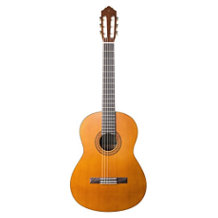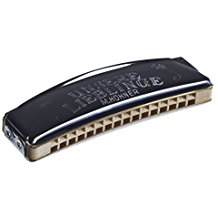Piano keyboard purchasing advice: how to choose the right product
- What You Need to Know
- The keyboard is an electronic keyboard instrument that offers a wide range of different sounds and rhythms.
- With the different settings, a whole band can be simulated.
- The many functions of the instrument can be used creatively.
- The keyboard is well suited for beginners to playing the piano.
More than just a spare piano
Making music is a wonderful hobby. If you dream of playing your favourite songs yourself one day, a keyboard is just the thing. This instrument is a true musical all-rounder. Anyone who masters it becomes a one-man band.
Usually, keyboards have 61 keys, built-in speakers and an automatic accompaniment. This function is the unique selling point of the keyboard. It simulates a whole band. The instrument accompanies the playing with different sounds and rhythms, for example with a drum kit or a bass. Various sounds or “instruments” can be set in the main voice, for example organs, flutes, trumpets, tone woods – depending on the design, there are almost no limits.
Many beginners start playing the piano on a keyboard. Compared to an acoustic instrument, it is much cheaper and lighter. It can be a good solution for beginners. In the long run, however, a keyboard is no substitute for a piano or electric piano. This is because keyboards have keys and piano sounds, but different sound and playing characteristics. A keyboard is more than just a substitute piano; it must be regarded as an instrument in its own right that opens up a wide range of possibilities beyond playing the piano. Well-known manufacturers of keyboards are Yamaha, Casio and Rockjam.
Pro points
- Many different sounds and functions
- Easy to learn
- Inexpensive purchase
- Low weight
- Can be easily connected to other devices
Drawbacks
- Sound is very different from acoustic instruments
- Not a true alternative to the piano
Who is a keyboard suitable for?
The keyboard is characterised by its beginner-friendliness. It is suitable for people of all ages who want to learn an instrument. Even without previous musical knowledge, progress can be made quickly on the keyboard. Its many functions make it ideal for creative minds who like to experiment with different sounds and techniques. Professional musicians have long used keyboards for writing and recording songs.
Children and also older beginners can try out on a keyboard whether playing a keyboard instrument suits them at all before they buy an expensive piano. If you want to play mainly classical piano pieces in the long term, a keyboard is not the right choice for you. Dynamics and expression like on the piano are not possible. Since most models have a smaller range than a piano, many pieces of classical piano literature cannot be played at all on a keyboard. However, the way a keyboard is played is perfectly suited for interpreting popular pop songs.
What is the difference between a keyboard and an electric piano?
An electric piano, unlike a keyboard, simulates the sound and feel of a piano. The main focus of an electric piano is always on playing the piano, which is why most models have no automatic accompaniment and are limited to various piano sounds. A keyboard offers many sounds and automatic accompaniment rhythms. Electric pianos are lighter and less expensive than acoustic pianos and require no maintenance. Unlike keyboards, however, most electric pianos are not designed to be transported often.
Where do the differences in playing feel and sound come from? Here, the touch dynamics are an important keyword. Inside a piano, a hammer is thrown against a string by a mechanism when a key is pressed. By striking a key with varying force, the tone can be changed. A light touch produces a soft tone, a strong touch a loud one.
It’s the touch that counts
Through touch dynamics, the musician can influence the volume of each individual note. This only became possible with the invention of the hammer mechanism in the 18th century. With keyboard instruments such as the organ or the harpsichord – the forerunner of the piano – the tone cannot be changed by the keystroke. This is how the piano got the name pianoforte, because the new mechanism made it possible to play a single note both softly (piano) and loudly (forte).
The keys of an acoustic piano can also be pressed with different ease. This is because low notes are produced by a long and thick string and high notes by a short and thin one. The lowest note offers the greatest resistance when struck, the highest note the least. After a key is struck, the strings continue to vibrate and the tone reverberates.
Electric pianos are equipped with weighted keys and touch response for an authentic playing feel. Many models also have a “graded” hammer action. “Graded” means that, as with a piano, the notes are gradually easier to strike from left to right. In addition, electric pianos have a reverb effect that simulates the resonance of real strings.
Keyboards have smooth-running plastic keys that are all equally easy to press down. With simple models, it makes no difference how hard a key is pressed, the sound is always the same. Many models, however, have a touch response that allows for more musical expression and can be turned off if desired. Only instruments in higher price categories offer a reverberation effect. Without it, a note stops as soon as the key is no longer pressed.
Many pieces written for the piano cannot be played on keyboards. They have 61 keys and thus a range of only five octaves. Pianos and electric pianos, on the other hand, have a range of seven and a half octaves with their 88 keys.
How is a keyboard constructed?
Everyone knows the keyboard with its white and black keys. Above it, at the left and right end of the keyboard, there is a loudspeaker. The most interesting thing is between the speakers, namely the control panel. Here you can select sounds and set functions. Depending on the model, the instrument is equipped with various connections at the back, which further expand the keyboard’s range of functions.
The keyboard
The keyboard is the unmistakable feature of keyboard instruments. It is noticeable that there is a white and a black row of keys. The front, white row represents the seven whole tones, the black row behind represents the five chromatic tones. The black keys are separated into groups of two and three by gaps in which two white keys lie next to each other. The white key to the left of each group of two is always called C. The path from note to note is called an interval. From C to C there are eight tone steps, this interval is called an octave.
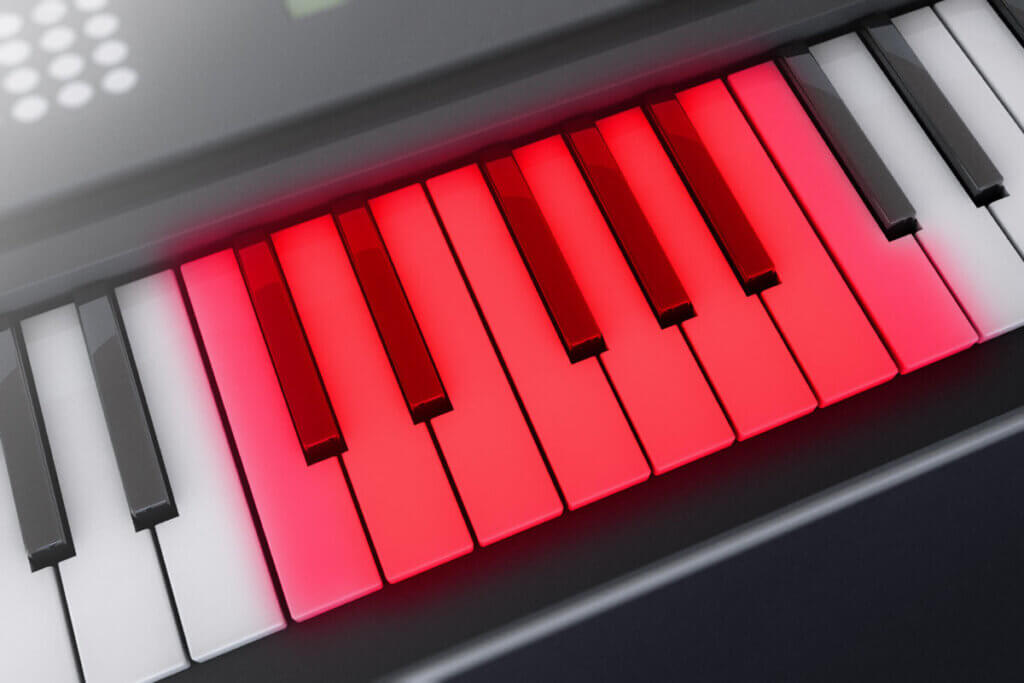
On the keyboard, the C in the middle is an important landmark. It is called c’ (dotted C). Many beginner pieces begin on this note. This is because the key of C major has no so-called accidentals and therefore does not need the black keys.
The features of a keyboard
On the top of a keyboard there are two loudspeakers on the left and right. This creates a stereo sound image. Below the keyboard there is often a connection for headphones. The control panel is located between the two speakers above the keyboard. What exactly is there depends on the equipment.
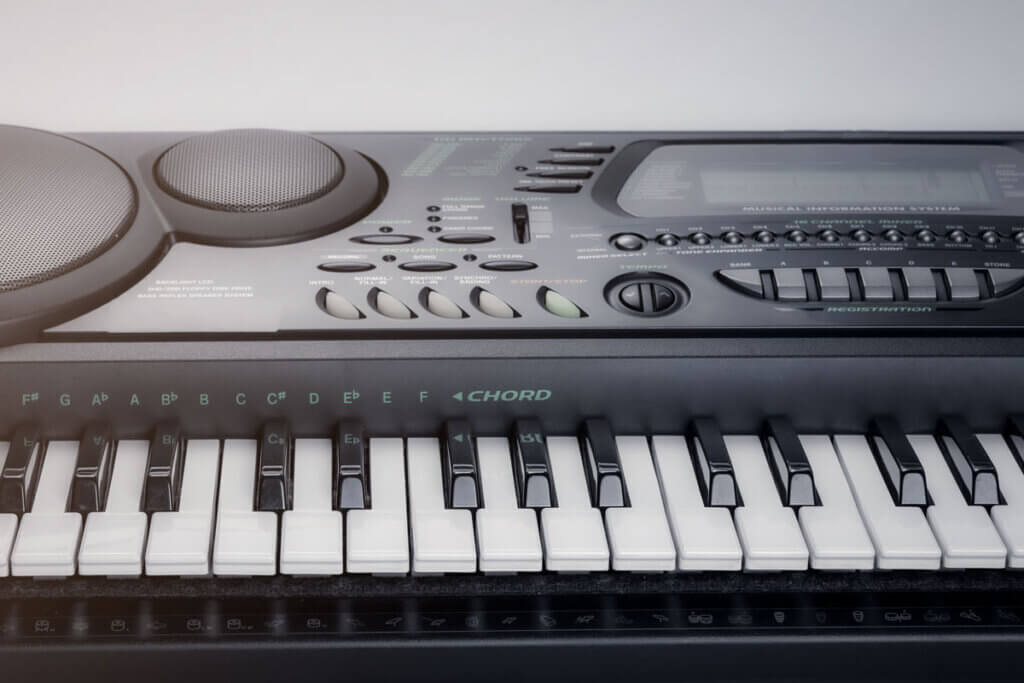
The basic elements include a button for switching on and off, a volume control, selection buttons for the various functions and sounds, and a display that shows which sounds and features are currently active. The various connections – with the exception of the headphone output – are mostly located at the back of the instrument. External devices are connected here. This expands the functions of the keyboard. The connections are usually labelled.
Choosing the right keyboard
A good keyboard has a wide range of functions and sounds. Beginners can choose a model with a smaller range of functions so that it remains clear for them. It is important that the sounds are of good quality and that the speakers also deliver a convincing sound. The keys on the keyboard must be stable and easy to grip.
The keyboard
Whether or not you enjoy making music depends to a large extent on the keyboard. A well-made keyboard is pleasant to touch and play. The individual keys must be easy to move and stable. The size of the keyboard keys can vary in width and depth. Small keys are particularly suitable for children who cannot yet grasp a whole octave. Adults choose the normal size.
A model with touch response is also recommended for beginners. Otherwise, the possibilities for musical expression are very limited, which quickly becomes frustrating. Choosing a model with this feature is especially important if you plan to switch to a piano or electric piano later.
Key weighting is only interesting for players who often use piano sounds. For the many other sounds that a keyboard offers, such a setting is not necessary. A guitar sound does not need a function that simulates the key weight of an acoustic piano. For certain sounds, such as organ or synthesiser, the smooth-action keyboard of the keyboard is more advantageous and authentic. Good keyboards often have key weighting that can be switched on and off. The decisive factor with the keyboard remains the playing feel, which is subjective.
Speakers and sound
Poor sound is annoying and frustrating not only for professionals, but also for beginners. If the sound is not right, playing is no fun. The quality of the built-in speakers is largely responsible for the sound of the instrument. The sound must be clear and balanced. Bass, middle and high tones must be in a harmonious relationship. The sound quality tends to increase with the price of the instrument. But even among inexpensive keyboards, models with reasonable loudspeakers can be found. If you are not satisfied with the sound quality of your keyboard, you can connect high-quality headphones or, depending on the connections available, upgrade to better speakers.
Sounds and Styles
A keyboard should have at least a solid basic set of sounds and rhythms (styles). A selected repertoire of good sounds is better than hundreds of sounds and styles, none of which are exhilarating. Many cheaper keyboards have a huge library of sounds, but these have been programmed for better models and then re-adapted. The quality suffers as a result.
A sound is a sound for the main voice that is modelled on a particular instrument, for example. Besides piano sounds, keyboards have almost every imaginable instrument in their range. With many models, the sounds can be changed with various effects such as reverb or chorus.
A style is a pattern that the keyboard uses to produce an accompaniment modelled on a certain musical style. This function is called automatic accompaniment. Styles are mainly used in live music.
Tip: The best styles
A keyboard is an entertainment instrument that brings zest to any party. The sounds and styles of dance music are not only interesting for professional entertainers. Classical dances are still very popular. Traditionally, there are the categories “Standard” and “Latin” with five dances each, which can be found on a keyboard under “Ballroom”.
The Automatic Accompaniment
The automatic accompaniment allows the keyboard player to perform as a one-person band. It accompanies and supplements the playing with different styles. The automatic accompaniment converts a played chord directly into a style. For example, if a samba style is selected and a C major chord is played, the automatic accompaniment plays a samba-style drum kit as well as the harmonically matching bass, guitar accompaniment and phrases typical of samba, for example on the trumpet. When a new chord is played, the automatic system reharmonises the accompaniment accordingly. With additional functions, the styles can be adapted to the classical structure of a song. The basic functions are “Intro”, “Main” – the main part of the piece – and “Ending”. With the automatic accompaniment, even beginners can quickly play songs that sound convincing. For those who want to practise and play without aids, however, this characteristic function of the keyboard is rather uninteresting.
The connections
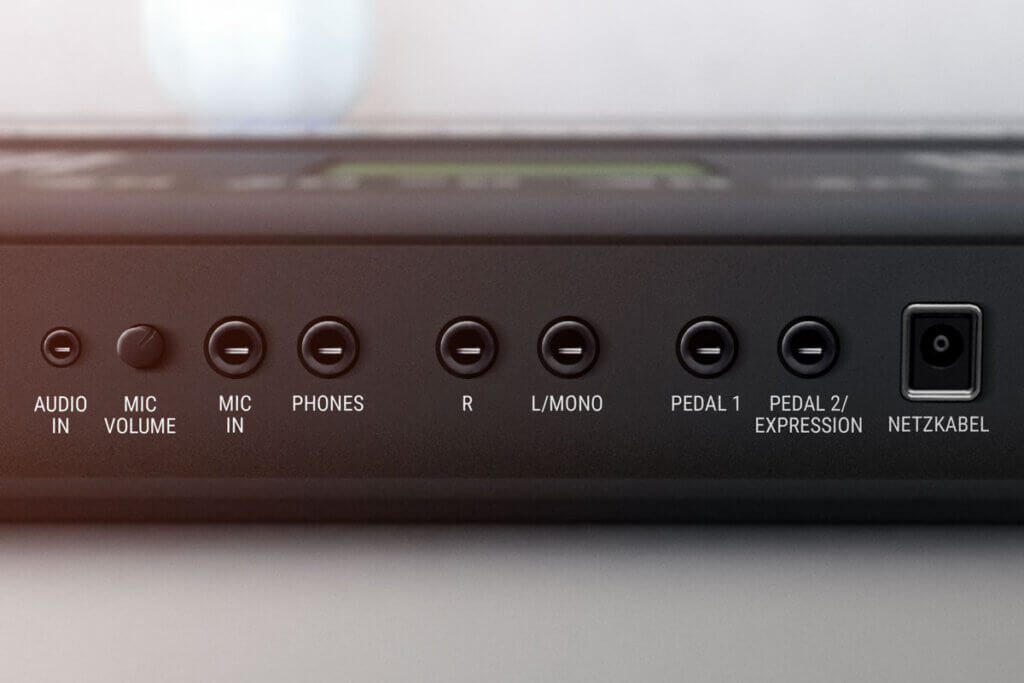
The connections determine which area of use a keyboard is suitable for. All keyboards have a power supply connection and at least one headphone output, which allows you to practise quietly or play during quiet times. As a rule, the built-in speakers are muted as soon as headphones are connected. On keyboards in the low-price segment, this connection is often the only way to connect an amplifier or mixer. It is often necessary to use an adapter. Common connections on a keyboard are:
- Power supply connection: The keyboard is connected to the power supply with a power cable.
- Pedal / Sustain / Expression: Pedals that manipulate the sound are connected here.
- Stereo input / Audio in / AUX: This allows the keyboard to play audio from a smartphone, MP3 player or other playback device through the built-in speakers.
- Stereo output / Out: Connects speakers, amplifiers, mixers and other external devices.
- USB: Connects the instrument to computers and MIDI devices. Transfers data to a USB stick.
- MIDI: Allows communication with a computer and other MIDI devices. A MIDI connection is interesting for professional musicians and tinkerers and allows to build a complex setup.
What is MIDI?
MIDI is a very useful tool for anyone who writes their own music. The abbreviation stands for “Musical Instrument Digital Interface”, which means “digital interface for musical instruments”. Computers, musical instruments and other devices communicate with each other via MIDI data. With various programmes, one’s own keyboard playing can be visualised on the computer. The most common is the piano roll editor, which displays a keyboard with a time progression. The MIDI notes can be easily edited and moved with this programme. It is also possible to have the keyboard produce certain sounds via the computer. USB is gradually replacing MIDI connections.
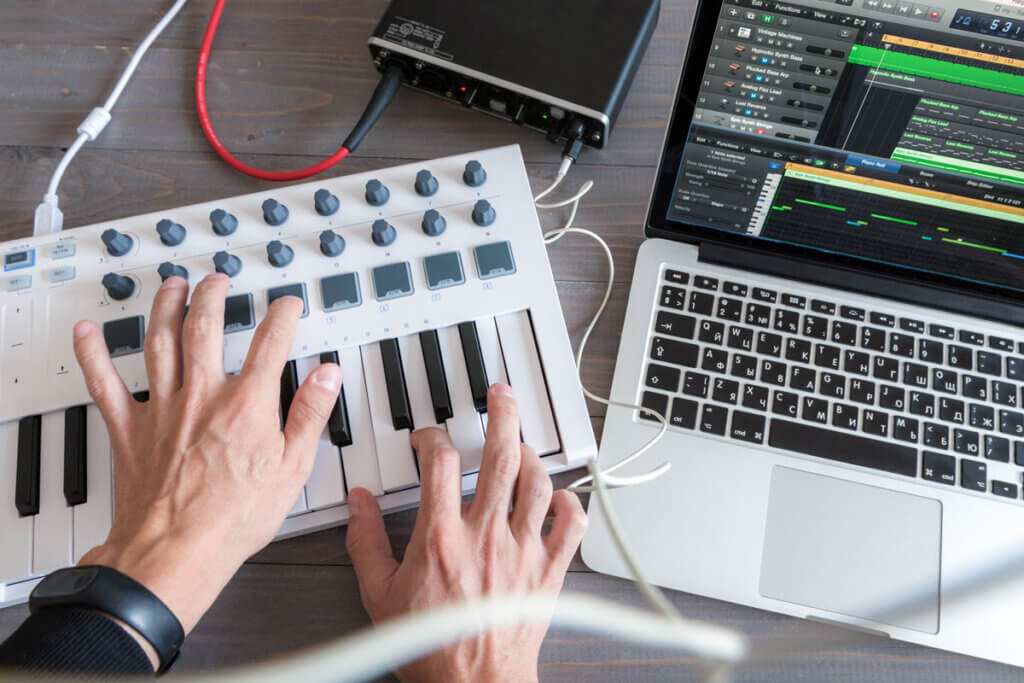
Additional functions and settings
One feature of the keyboard is its wide range of functions, which make many gimmicks possible. The functions make writing music easier, are practical for playing in a band, or create completely new timbres.
If you use the keyboard for composing and have a good idea, you would prefer to record and save it directly before it gets lost. Most keyboards have a MIDI recording function. However, the integrated memories of low-priced models are not too large. They are enough to hold an idea, but not for fully developed compositions. Extensive editing options are often not to be found either. For this, it is advisable to connect the keyboard to a computer.
Keyboardists who play in front of an audience do not want to do without split and layer functions. The split function allows you to divide the keyboard into different sections and assign different sounds to these sections. With the layer function, sounds are superimposed to create a new impression. Often, split and layer can be set at the same time. Then, for example, piano and trumpet play on the right half and a bass on the left half.
If you have found a setting that you particularly like, you may want to save it so that you can use it again quickly. With the registration memory, a setting can be easily assigned to a slot. This way, favourite settings are only a button press away. This is especially useful for performances when you need to quickly switch between settings.
Higher-priced keyboards offer some options for changing the sound while playing with effects. The reverb and chorus effects are among the most commonly used. Chorus is a modulation effect that creates multiple slightly delayed copies of a sound, giving it a floating character. Reverb – often called reverb – creates an artificial reverberation and makes sounds seem more spacious. Some keyboards have a pitch bender on the side. This wheel can be used to simulate the playing possibilities of stringed instruments.
Keyboard accessories
Accessories for the keyboard do not expand the functions or improve the playing, but they are immensely practical nonetheless. A bag protects the stored instrument from dust. With it, you can easily take it to rehearsals or performances. It is not always possible to place the keyboard on a table. Therefore, it is worth buying a keyboard stand not only for band rehearsals. These are usually x-shaped, height-adjustable and foldable. When playing keyboard and piano, a stool ensures that the correct posture is maintained. Just like the stands, the stools can be adjusted in height and folded.
Other functions
Many models have learning programmes, which is particularly pleasing for beginners. This makes it possible to learn some of the integrated songs step by step. In this way, even inexperienced keyboard players can quickly build up a small repertoire of familiar songs. Some models also have illuminated keys that make practising easier. It should be noted that keyboards that are not intended as beginner models often do not have extensive song collections and practice programmes.
Different keyboard models
Keyboards differ in design depending on the price segment. The price range in which interested buyers should look depends primarily on their playing level. Beginners are best advised to look at the price range up to 200 euros. Here you will find many models with solid basic equipment. Advanced players want more functions. Mid-priced models up to 500 euros are suitable for them. More expensive keyboards are for professionals who perform live or compose music.
Keyboards for beginners
Keyboards in the low price segment are usually aimed at users who are just starting to play the piano or keyboard. Beginners often shy away from large investments because they don’t yet know whether they will be enthusiastic about playing the keyboard in the long term. Suitable models are available for under 200 euros. Instruments for beginners must be convincing, especially when it comes to basic equipment. This includes:
- A keyboard that is easy to play
- Flawless sound quality of the loudspeakers
- High-quality sounds and styles
- Solid workmanship
- Ease of use
Beginners are advised not to buy a model without touch response – especially if classical piano pieces are to be practised. If you want to use the keyboard for a longer period of time and develop a feeling for musical expression, you will have to rely on the touch response. Without it, playing pop songs and piano pieces is no fun.
Because external speakers are not likely to be connected to the keyboard for home use, the built-in speakers should produce a good sound. No one likes to practise if their own playing is distorted and rattling.
Sufficient quality is also important for the integrated sounds and accompaniment rhythms. The size of the library is secondary, because hundreds of sounds and rhythms are standard on modern keyboards anyway. With entry-level models, they are often borrowed from the repertoire of an older, higher-quality instrument from the same manufacturer. However, the adaptation of the sounds does not happen without more or less significant losses in quality. But even among the entry-level models, there are instruments that offer sufficiently good sound quality. It is important that sounds and styles have a certain depth and seem lively.
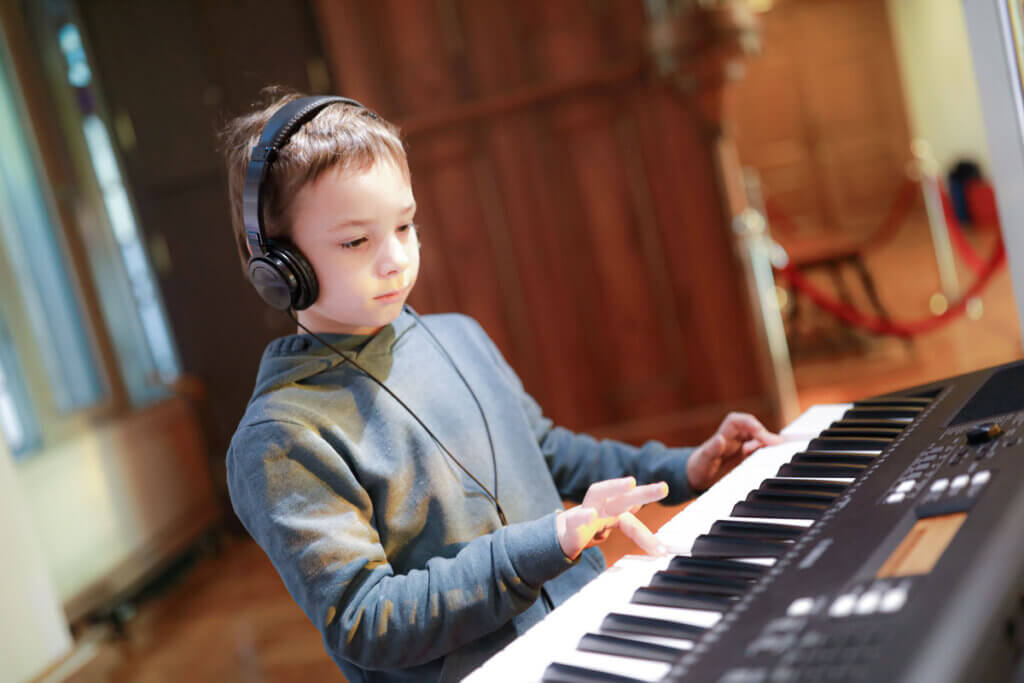
For a beginner, ease of use is more important than a wide range of functions. The control panel should be particularly user-friendly, with knobs and clear displays as well as clear naming of functions, sounds and connections. A practical extra for beginners are tutorials and illuminated buttons.
Functions beyond a solid basic configuration are not particularly important for many beginners at first. As far as connections are concerned, a headphone output and a pedal socket are the minimum standard. A stereo input can be interesting for beginners who want to play music on the keyboard. Other connections and the functions associated with them are more interesting at a higher level of playing. The same applies to the operating functions. Everything that goes beyond sounds and styles is not important for beginners. This includes rudimentary recording functions, which many models in the range up to 200 euros have. Many beginners may feel overwhelmed by a wide range of functions. Those who plan to switch to the piano after an initial practice phase will not need many of the functions anyway.
As far as connections are concerned, the minimum standard for an entry-level keyboard is a headphone output and a pedal connection. Depending on how the instrument is used, other connections become important. If you want to play music on the keyboard, you need a stereo input.
Pro points
- Reasonable price
- Many sounds and styles
- Clear number of options
Drawbacks
- Sacrifices in the overall quality
- Functions quickly exhausted
Keyboards for advanced players
For advanced players and ambitious beginners, it is worth taking a look at the mid-price segment (200 to 500 euros). Beginners who have familiarised themselves with all the functions of their entry-level device need a model that offers more possibilities. Advanced players no longer want to just learn and master the instrument, but become creative themselves and test out the various functions of the keyboard. These models have much more to offer in terms of sound and range of functions than beginner models.
Those who have mastered the basics of playing and have reached a certain level will want to try out the automatic accompaniment. Interested musicians should pay attention to which sounds are integrated and how good the various rhythms are. Good mid-range keyboards have registration memories, recording functions and effect and sound settings. These functions must be fully usable and not gimmicks like entry-level models have. If you want to write songs or perform live, you need various connection options such as USB, MIDI and a stereo output.
Pro points
- Has all the important functions
- Higher quality
- Moderate prices
Drawbacks
- Does not yet reach the quality of a professional device
- High investment for a beginner
Keyboards for professionals
These keyboards are true entertainment machines and are not suitable for someone who only wants to practise the piano from time to time. These instruments (from 500 euros) appeal to professional musicians who want to use the keyboard on stage or in the recording studio. Therefore, they leave little to be desired in terms of sound and range of functions. The keyboards of these models can be played particularly dynamically and are equipped with aftertouch. The high-quality sounds react in great detail to different keystrokes. Large, graphic-capable displays provide even more operating comfort. Since these instruments belong on stage, they are particularly stable and robust. The higher the price, the better and more extensive the design. If you want, you can spend well over 1,000 euros on a professional keyboard. These instruments are not interesting for hobby musicians and beginners who might not even use many of the functions.
Pro points
- Especially many functions
- Extremely high quality
- Moderate prices
Drawbacks
- Very high prices
- Not suitable for beginners

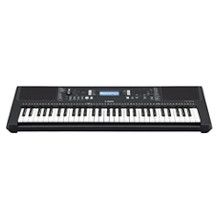
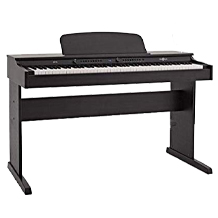
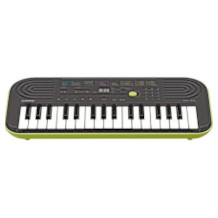
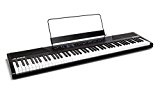
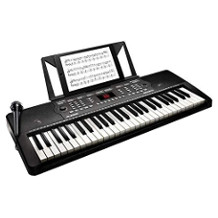
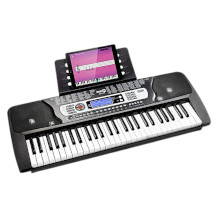

 4,783 reviews
4,783 reviews
